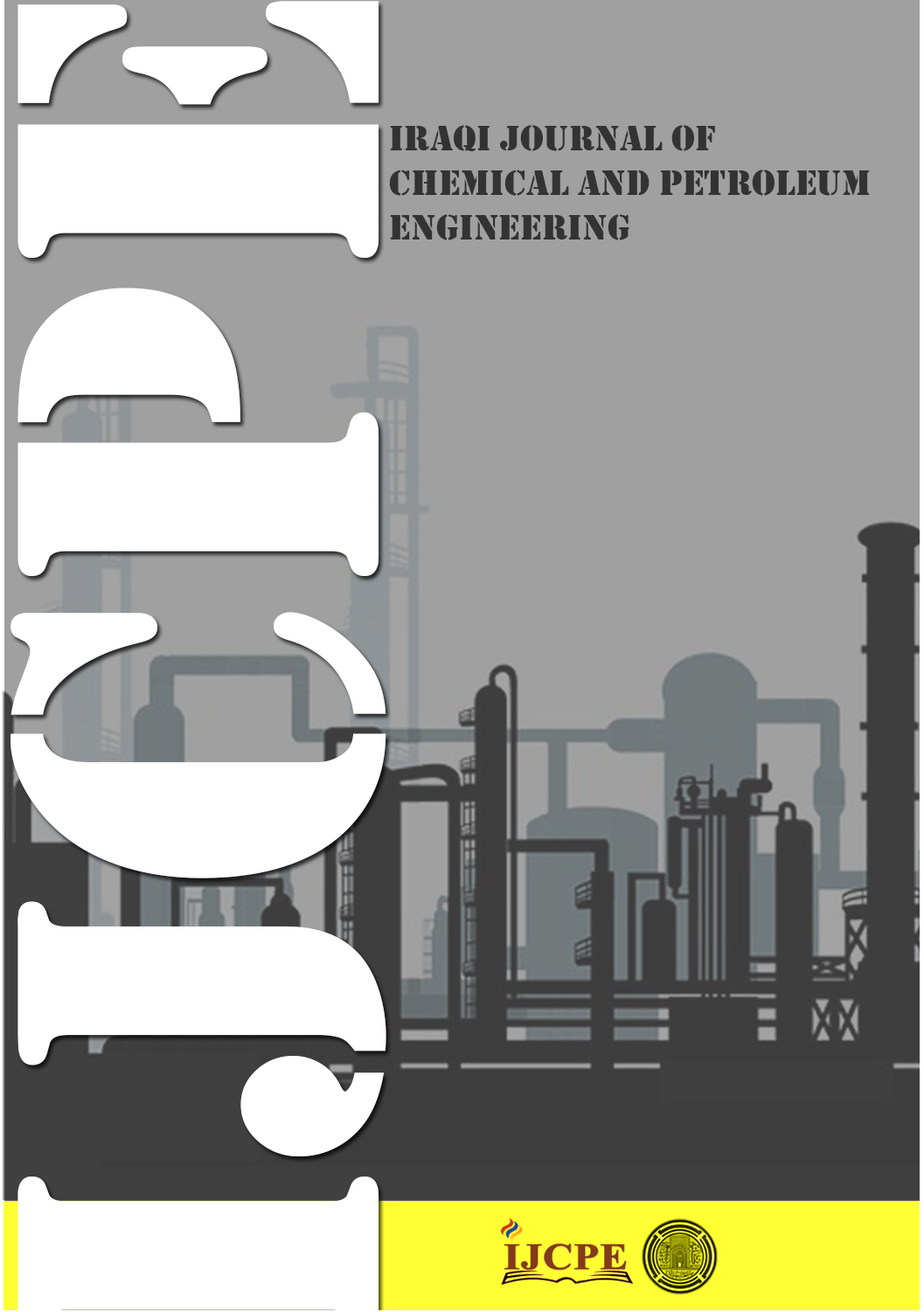Characterization of copper based chitosan nanoparticles synthesis by chemical method: Approach cytotoxic effects on MCF-7 cells
DOI:
https://doi.org/10.31699/IJCPE.2025.3.5Keywords:
FTIR; MCF7; cytotoxicity chitosan; copper nanoparticle (Chi-Cu NPs); TEMAbstract
Chitosan polymer is an essential supporting material for the synthesis of metallic nanoparticles (MNPs) because of its exceptional capping and stabilizing qualities, biocompatibility, biodegradability, eco-friendliness, polycationicity, and non-toxicity. To produce copper-based chitosan nanoparticles, choose a suitable chemical procedure hydrothermal method. Each approach offers advantages in terms of homogeneity, morphology, and particle size. This study has produced, described, and examined the bacteriological characteristics of metal nanoparticles based on chitosan, including copper nanoparticles (CS-Cu NPs). Chitosan-based metal nanoparticles have been created using the solution casting technique. The generated nanoparticles were characterized using FTIR, AFM, UV, ZP, and SEM examination. The TEM image illustrates that the materials created are nanomaterials, ranging in size from 1 to 100 nm. The CS-CuNPs, displaying a stable brick-red hue, showed an absorption peak at 214 nm, indicative of monodisperse nanoparticle formation and surface plasmon resonance. X-ray diffraction confirmed the face-centered cubic structure with peaks at 36.78°, 43.38°, 50.56°, and 74.26°, and an average particle size by AFM to 62.45 nm. FTIR analysis showed interactions between chitosan and copper, particularly around 3370 –3226 cm⁻¹, 1633 cm⁻¹, and 680 cm⁻¹ and.The MCF7 cell line demonstrated the strongest anti-human breast cancer cell line properties of the nanocomposite when compared to the aforementioned cell lines. The aforementioned results suggest that the nanocomposite could be used to treat various forms of human breast cancer. Breast cancer had increased nanoparticle sensitivity. At a concentration of 25 μL/mL, Chi-Cu NPs demonstrated excellent cytotoxicity and anticancer activity, making them suitable for use as an anticancer agent.
Received on 12/12/2024
Received in Revised Form on 09/03/2025
Accepted on 09/03/2025
Published on 30/09/2025
References
[1] B.Ates, S.Koytepe, A.Ulu, C.Gurses, & V.K.Thakur. Chemistry, structures, and advanced applications of nanocomposites from renewable resources. Chemical Reviews, 120(17), 9304-9362. 2020. https://doi.org/10.1021/acs.chemrev.9b00553
[2] A.Khan, & K.A.Alamry. Recent advances of emerging green chitosan-based biomaterials with potential biomedical applications: A review. Carbohydrate Research, 506, 108368. 2021. https://doi.org/10.1016/j.carres.2021.108368
[3] S. N. Banitaba, S. V. Ebadi, P.Salimi, A. Bagheri, A. Gupta, W. U. Arifeen, V. Chaudhary, Mishra , Y. K. Kaushik , & E. Mostafavi. Biopolymer-based electrospun fibers in electrochemical devices: a versatile platform for energy, environment, and health monitoring. Materials Horizons, 9(12), 2914-2948. 2022. https://doi.org/10.1039/D2MH00879C
[4] A. Detsi, E. Kavetsou, I. Kostopoulou, I. Pitterou, A. R. N. Pontillo, A. Tzani, P. Christodoulou, A. Siliachli, & P. Zoumpoulakis. Nanosystems for the encapsulation of natural products: The case of chitosan biopolymer as a matrix. Pharmaceutics, 12(7), 669. 2020. https://doi.org/10.3390/pharmaceutics12070669
[5] Z. M. Romi and M. E. Ahmed, “Influence of biologically synthesized copper nanoparticles on biofilm formation by Staphylococcus haemolyticus isolated from seminal fluid,” Iraqi Journal of Science, vol. 1948–1968, 2024. https://doi.org/10.24996/ijs.2024.65.4.15
[6] Akbar, S., Qureshi, M. N., & Khan, S. A. Fabrication of chitosan supported copper nano catalyst for the hydrogen gas production through methanolysis and hydrolysis of NaBH4. International Journal of Hydrogen Energy, 101, 313-322. 2025. https://doi.org/10.1016/j.ijhydene.2024.12.462
[7] Su, C., Chen, A., Liang, W., Xie, W., Xu, X., Zhan, X., ... & Peng, C. Copper-based nanomaterials: Opportunities for sustainable agriculture. Science of The Total Environment, 171948. 2024. https://doi.org/10.1016/j.scitotenv.2024.171948
[8] Ghasemi, P., Shafiee, G., Ziamajidi, N., & Abbasalipourkabir, R. Copper nanoparticles induce apoptosis and oxidative stress in SW480 human colon cancer cell line. Biological Trace Element Research, 201(8), 3746-3754. 2023.
https://doi.org/10.1007/s12011-022-03458-2
[9] Huang, T., Ma, K., & Wang, Y. Characterization and evaluation of the cytotoxic, antioxidant, and anti-human lung cancer properties of copper nanoparticles green-synthesized by fennel extract following the PI3K/AKT/Mtor signaling pathway. PloS one, 20(1), e0309207. 2025. https://doi.org/10.1371/journal.pone.0309207
[10] S. Mallick, S. Sharma, M. Banerjee, S. S. Ghosh, A. Chattopadhyay &A. Paul. Iodine-stabilized Cu nanoparticle chitosan composite for antibacterial applications. ACS applied materials & interfaces, 4(3), 1313-1323. 2012. https://doi.org/10.1021/am201586w
[11] M. R. Mehta, H. P. Mahajan, & A. U. Hivrale. Green synthesis of chitosan capped-copper nano biocomposites: Synthesis, characterization, and biological activity against plant pathogens. BioNanoScience, 11, 417-427. 2021. https://doi.org/10.1007/s12668-021-00823-8
[12] N. H. H. Faiq and M. E. Ahmed, “Inhibitory effects of biosynthesized copper nanoparticles on biofilm formation of Proteus mirabilis,” Iraqi Journal of Science, pp. 65–78, 2024. https://doi.org/10.24996/ijs.2024.64.1.7
[13] Z. H. Kadhim, M. E. Ahmed, and I. Şimşek, “Biologically synthesized copper nanoparticles from S. epidermidis on resistant S. aureus and cytotoxic assay,” Bionatura, vol. 8, no. 1, 2023. https://doi.org/10.21931/RB/CSS/2023.08.01.54
[14] A. H. Alhammer, S. I. Al-junior, and S. A. Mudhafar: APR-246 enhances the anticancer effect of doxorubicin against p53-mutant AsPC-1 pancreatic cancer cells. Baghdad Science journal 21: 2551-2560, 2024. https://doi.org/10.21123/bsj.2024.10135
[15] Z. J. S. Hassan, M. K. Hamid, & M. E. Ahmed. Synthesized Zinc Oxide Nanoparticles by the Precipitation Method on Streptococcus spp. from Dental Carries and Cytotoxicity Assay. International Journal of Drug Delivery Technology. 12, 1327-1330. 2022. https://doi.org/10.25258/ijddt.12.3.65
[16] S. M. Mahdi, A. F. Abbas, M.E. Ahmed. Cytotoxicity of zinc oxide nanoparticles to lymphocytes using Enterococcus faecium bacteriocin and assessment of their antibacterial effects. Nanomedicine Research Journal. 2024.9(2): 180-194. 2024. https://doi.org/10.22034/NMRJ.2024.02.007
[17] A. Regiel, S. Irusta, A. Kyziol, M. Arruebo, J. Santamaria. Preparation and characterization of chitosan - silver nanocomposite films and their antibacterial activity against Staphylococcus aureus. Nanotechnology- IOPscience. 2013. https://doi.org/10.1088/0957-4484/24/1/015101
[18] C. Covarrubias, D. Trepiana & C. Corral. Synthesis of hybrid copper-chitosan nanoparticles with antibacterial activity against cariogenic Streptococcus mutans. Dental Materials Journal, 37(3), 379-384. 2018. https://doi.org/10.4012/dmj.2017-195
[19] T. T. Hanh, L. Chi & N. N. Duy. Fabrication of copper nanoparticles/diatomite nanocomposite by irradiation method for antibacterial application. Aquaculture Reports. 27, Article ID 101342. 2022. https://doi.org/10.1016/j.aqrep.2022.101342
[20] M. H. Sarfraz, M. Zubair , B. Aslam , A. Ashraf , M. H. Siddique S. Hayat , J. N. Cruz , S. Muzammil, M. Khurshid , M. F. Sarfraz , A. Hashem , T. M. Dawoud , G. D. Avila-Quezada & E. F. Abd_Allah. Comparative analysis of phyto-fabricated chitosan, copper oxide, and chitosan-based CuO nanoparticles: antibacterial potential against Acinetobacter baumannii isolates and anticancer activity against HepG2 cell lines. Antimicrobials, Resistance and Chemotherapy. 14:1188743. 2023. https://doi.org/10.3389/fmicb.2023.1188743
[21] I. Khan, K. Saeed, & I. Khan. Nanoparticles: properties, applications and toxicities. Arabian Journal of Chemistry. 12, 908–931. 2019. https://doi.org/10.1016/j.arabjc.2017.05.011
[22] M. R. Mehta, H. P. Mahajan, & A. U. Hivrale. Green synthesis of chitosan capped-copper nano biocomposites: Synthesis, characterization, and biological activity against plant pathogens. BioNanoScience, 11, 417-427. 2021. https://doi.org/10.1007/s12668-021-00823-8
[23] Z. Hongfeng, A. El-Kott, A. E. Ahmed, & A. Khames. Synthesis of chitosan-stabilized copper nanoparticles (CS-Cu NPs): Its catalytic activity for CN and CO cross-coupling reactions and treatment of bladder cancer. Arabian Journal of Chemistry, 14(10), 103259. 2021. https://doi.org/10.1016/j.arabjc.2021.103259
[24] Z. Shi, Y. Mahdavian, Y. Mahdavian, S. Mahdigholizad, P. Irani, M. Karimian & M. M. Zangeneh. Cu immobilized on chitosan-modified iron oxide magnetic nanoparticles: Preparation, characterization and investigation of its anti-lung cancer effects. Arabian Journal of Chemistry, 14(8), 103224. 2021. https://doi.org/10.1016/j.arabjc.2021.103224
Downloads
Published
Issue
Section
License
Copyright (c) 2025 The Author(s). Published by College of Engineering, University of Baghdad.

This work is licensed under a Creative Commons Attribution 4.0 International License.













